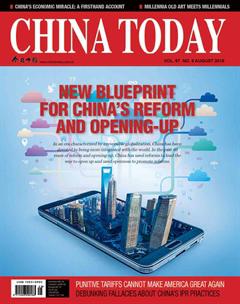China Embraces WTO Rules with More Balanced Foreign Trade
At its 2018 mid-year report meeting, the China Forum of Macroeconomics Research announced that in the first half of 2018, Chinas economic growth rate was 6.8 percent, ranking high among the worlds major economies.
Chinas economy has enjoyed stable performance with good momentum for more robust growth: domestic demand has been vigorous; bulk commodities like crude oil have seen continuously increasing prices; the import volume has kept rising, which has made the countrys trade surplus drop by more than 30 percent. Meanwhile as China further removes its market access barriers for foreign companies, newly registered foreign invested enterprises have consequently increased by 97.6 percent year on year.
In this context, China possesses great potential in expanding its imports in a range of fields including high-end goods, high valueadded commodities, advanced equipment, and precision instruments. On June 28, the State Council Information Office released the white paper China and the World Trade Organization, which estimates that China will import products worth US $24 trillion in the next 15 years.
Besides the burgeoning import of goods, Chinas services trade has also been expanding. Its foreign trade has become increasingly balanced on the whole.
On the pretext of trade deficit, the United States started a trade war against China, which is showing its ripple effect across the world. But actually, the deficit only stands when judged solely from goods trade; when it comes to the services trade, America has enjoyed a long-standing surplus.
As global industrial chains become even more integrated, the U.S. high value-added design and R&D; sectors have gotten even more intertwined with Chinas low-cost manufacturing and assembling industries, thus forming a body of shared interests. China has imported services hugely from the U.S. in fields such as designing, marketing, logistics, retail, financing, and accounting. According to statistics from the Office of the United States Trade Representative (USTR), America exported services of US $54.2 billion to China, representing an 11.6 percent increase year on year. The USTR points out in particular that, it is a 412 percent rise over 2006, and an even sharper increase of 908 percent when compared to 2001. According to USTR, intellectual property authorization for tourism, trademarks, and computer software are the main types of exported services.
In tourism, Chinas Ministry of Commerce estimates that in 2016, the average spending for each Chinese tourist in the United States was US $13,000, which is considerably higher than that of tourists from other countries. In the same year, Chinese tourists spent over US $35.2 billion in the U.S. in total, i.e. US $97 million for each day.
In education, America has been the most popular destination for Chinese overseas students. A report issued by the U.S. Immigration and Customs Enforcement in May 2016 stated that, the number of Chinese students in the U.S. reached 353,000, accounting for 34 percent of all the international students in the country. Chinas Ministry of Commerce estimates that in 2016, each Chinese overseas student paid on average US $45,000, generating a revenue of US $15.9 billion for the U.S.
The U.S. is a major source of Chinas services trade deficit. If the trade frictions between the two cause China to take counter measures, the services trade would be affected. Nonetheless, China continues to open up its service industry to foreign firms.
A consensus was reached in the 2017 meeting of heads of the two countries: The restrictions on foreign companies entry to Chinas financial industry will be lifted in five years. Currently, China has removed many roadblocks for foreign investors in the financial industry including banking, securities, funds, and insurance to facilitate their entry to the domestic market.
Among the 160 service trade sectors defined by the WTO, China has opened 120 to foreign investment, thus more than honored its commitment of 100 when it initially joined, including fields such as research & development, mining, education, insurance, securities, banking, air transport, to name a few. Next, China will open wider sectors such as finance, telecommunications, medical care, education, and elderly care.
Gao Feng, speaker of the Ministry of Commerce, stated that in the near future, China will see an increasing deficit in its services trade. And as China enters the high-quality development phase, demands for high-quality services will soar, especially in industries like intellectual property.
China is intent on elevating its position in the global services trade value chain. To this end, China will improve international cooperation on all fronts. Meanwhile, China will also leverage the services trade to propel its major national strategies related to the Guangdong-Hong Kong-Macao Greater Bay Area, the Yangtze River Economic Belt, and the Beijing-Tianjin-Hebei Area. In this process, China will bring Hong Kongs advantages in the services trade to full play, and integrate them with the mainlands advantages, thus creating a competitive edge in the services trade with Chinese characteristics.

